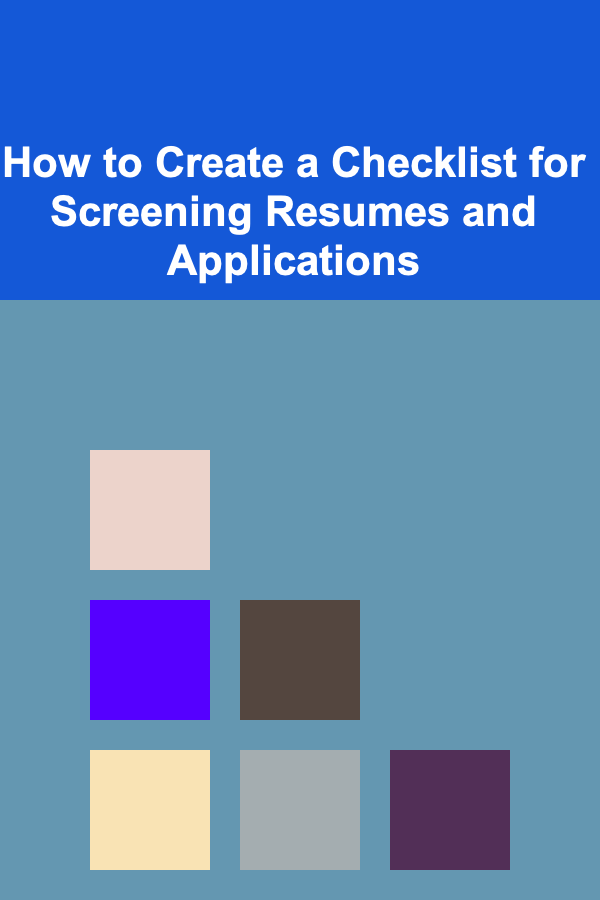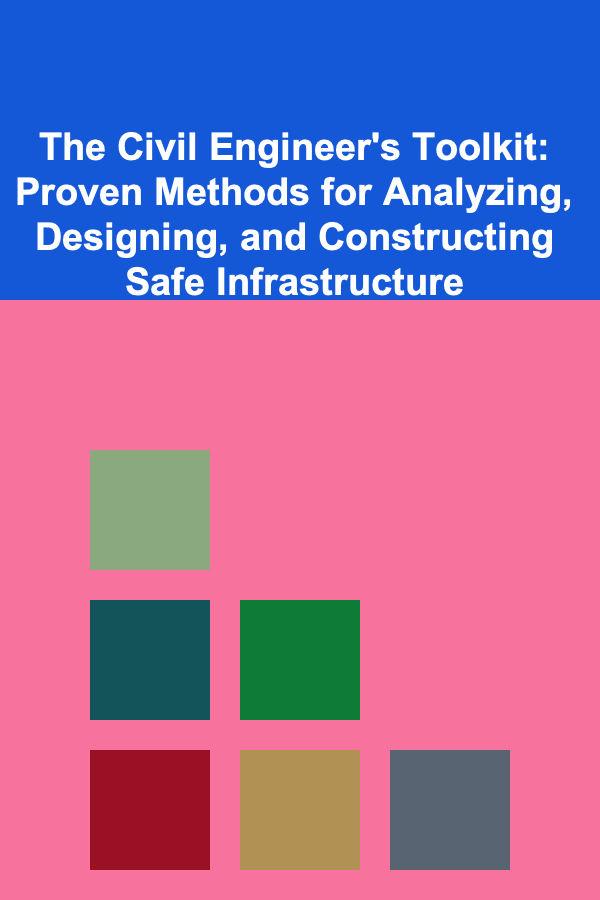
How to Create a Checklist for Screening Resumes and Applications
ebook include PDF & Audio bundle (Micro Guide)
$12.99$6.99
Limited Time Offer! Order within the next:

In today's competitive job market, hiring managers and recruiters face an overwhelming number of resumes and applications for every position they post. Sorting through these can be time-consuming and, at times, overwhelming. One of the most efficient ways to streamline this process is by creating a comprehensive checklist for screening resumes and applications. This actionable guide will help you craft a checklist that ensures you're evaluating candidates systematically, saving time, and improving your chances of finding the best talent.
Step 1: Define Your Ideal Candidate
Before creating a checklist, it's essential to define what an ideal candidate looks like for the position. This step will serve as the foundation for every other part of your screening process.
1.1 Review the Job Description
Start by revisiting the job description to clearly outline the qualifications, experience, skills, and attributes required for the role. Key elements to consider include:
- Required Skills: What hard and soft skills are critical for success in the position?
- Experience: How many years of experience are necessary? Is industry experience crucial?
- Education: What level of education or certifications are required?
- Cultural Fit: What traits will make the candidate a good cultural fit for the team and company?
Ensure that these criteria are specific and measurable. General statements like "good communicator" can be subjective, while more specific statements like "excellent written and verbal communication skills" provide clearer guidance for screening.
1.2 Identify Non-Negotiable Requirements
Determine which aspects of the job description are non-negotiable. For example, if a job requires a certain degree or certification, these items should be at the top of your checklist. Non-negotiable requirements could include:
- Minimum years of experience
- Specific technical skills or software proficiency
- Relevant certifications or licenses
These must be flagged immediately, as they are essential for a candidate to even be considered for the role.
Step 2: Create a Screening Framework
Once you've defined the key characteristics of your ideal candidate, it's time to build a screening framework. This framework should address all aspects of the resume and application, from basic qualifications to more nuanced factors like personality traits and presentation.
2.1 General Screening Criteria
2.1.1 Contact Information and Professionalism
The first thing to check is whether the candidate has provided their full name, phone number, email address, and location (if relevant). Ensure that:
- The email address looks professional (i.e., not something like [email protected]).
- The phone number is valid and can be easily contacted.
- Their location is either appropriate for the job or, in the case of remote work, clearly stated.
2.1.2 Resume Format and Structure
A resume should be easy to navigate and well-organized. Look for resumes that have:
- A clear structure (e.g., contact information, experience, education, skills).
- Consistency in font size, headings, and bullet points.
- No excessive jargon or irrelevant information.
- Proof of attention to detail (no spelling or grammatical errors).
2.1.3 Tailored Applications
Check if the resume is tailored to the specific job description. Candidates who customize their resumes for each application tend to be more engaged and interested in the role. Look for:
- A clear objective or summary that aligns with the job.
- Experience listed that directly correlates to the job requirements.
- Keywords and phrases from the job description included to demonstrate attention to the role's needs.
2.2 Experience Screening
2.2.1 Relevance of Work Experience
Evaluate the relevance of the candidate's experience. Look for:
- Previous roles that are similar in nature to the job you're hiring for.
- Specific accomplishments, achievements, or key performance indicators (KPIs) from their previous roles.
- A clear progression in their career (promotions, new responsibilities).
If a candidate has experience in a similar position, they may require less training and have a smoother transition into the role.
2.2.2 Duration in Roles
Examine how long the candidate stayed at each position. Short stints may indicate instability or a lack of commitment, but this can vary depending on industry standards or personal circumstances. Key questions to consider:
- Are there long gaps between roles? If so, were they explained (e.g., personal development, travel, education)?
- Are the job durations consistent with the industry?
While frequent job changes may raise concerns, they can also suggest adaptability, especially in industries that change rapidly (e.g., tech, marketing).
2.3 Education and Certifications
2.3.1 Minimum Education Requirements
Ensure that the candidate meets the educational requirements listed in the job description. However, remember that relevant experience and skills might outweigh formal education, depending on the role.
- Check for degrees, diplomas, or certifications that align with the position.
- Note if the candidate has pursued additional relevant training or development programs.
2.3.2 Certifications and Licenses
For certain roles, certifications or specific licenses might be non-negotiable. Verify that the candidate has the proper credentials, especially in fields like healthcare, technology, finance, or law.
- Ensure that certifications are up to date and relevant.
- For technical positions, certifications from reputable bodies (e.g., Cisco, AWS, PMP) are highly valuable.
2.4 Skills and Competencies
2.4.1 Hard Skills
Look for evidence that the candidate possesses the necessary technical skills for the role. Hard skills might include:
- Software proficiency (e.g., Microsoft Office, Adobe Creative Suite, specific programming languages).
- Data analysis, project management tools, or industry-specific skills (e.g., SEO, CAD, UX design).
Check for both industry-specific tools and general tools that are relevant to the role.
2.4.2 Soft Skills
While harder to quantify, soft skills like communication, problem-solving, and leadership are equally important. Look for evidence of these skills in the experience and achievements section of the resume:
- Examples of successful team projects or collaborations.
- Leadership roles or initiatives that showcase the candidate's interpersonal abilities.
- Problem-solving examples, especially when candidates describe challenges they've overcome.
Step 3: Build a Scoring System
To make the screening process more objective and structured, consider implementing a scoring system for each criterion. A scoring system helps ensure consistency and allows you to compare candidates more effectively. You can score each resume or application on a scale of 1 to 5 (or another scale that suits your needs), where:
- 1 = Does not meet requirements
- 2 = Partially meets requirements
- 3 = Meets requirements
- 4 = Exceeds requirements
- 5 = Exceptional
Assign scores to each section of your checklist (e.g., experience, education, skills, etc.). At the end of the screening process, candidates who score highest on each section are those who are most aligned with the position and should be considered for the next stage.
Step 4: Eliminate Bias and Ensure Fairness
It's important to maintain objectivity throughout the screening process. Unconscious bias can influence your decision-making, so it's critical to keep the following in mind:
- Stick to the job criteria and avoid subjective judgments based on gender, age, race, or personal opinions.
- Use your checklist as a standardized method for evaluating candidates.
- Consider implementing blind recruitment, where identifying information is removed from the resume (such as names, photos, and addresses) to focus solely on qualifications.
Additionally, regularly review and update your checklist to ensure it reflects the changing needs of the organization and job market trends.
Conclusion
Creating a checklist for screening resumes and applications is an essential part of the hiring process. It helps streamline your recruitment efforts, ensures consistency in evaluating candidates, and improves your chances of finding the right person for the job. By defining your ideal candidate, setting clear criteria, using a structured scoring system, and minimizing bias, you will be able to make more informed and objective hiring decisions. A well-constructed screening checklist is not only an effective tool for filtering candidates but also a key factor in building a stronger, more successful workforce.

How to Choose the Right Home Security Cameras for Your Property
Read More
How to Make Money by Taking Online Surveys and Participating in Research
Read More
How to Select a Color Palette for Budget Decorating
Read More
How to Set Up a Comfortable Ergonomic Study Area
Read More
How to Use Smart Technology to Enhance Your Home Security
Read More
The Civil Engineer's Toolkit: Proven Methods for Analyzing, Designing, and Constructing Safe Infrastructure
Read MoreOther Products

How to Choose the Right Home Security Cameras for Your Property
Read More
How to Make Money by Taking Online Surveys and Participating in Research
Read More
How to Select a Color Palette for Budget Decorating
Read More
How to Set Up a Comfortable Ergonomic Study Area
Read More
How to Use Smart Technology to Enhance Your Home Security
Read More